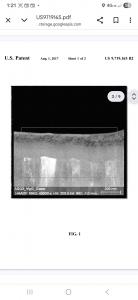Breakthrough Ceramic Coated Glass Technology Achieves Extremely High Young's Modulus of 189 GPa
The Ceramic Coated Glass is Designed Especially for Scratch Resistance and Strength Desirable in Many Industries Such as Smartphones, Architectural Glass, etc.
We are very excited about this measurement for a number of reasons. One of them is that it is now possible to improve the scratch resistance of super thin glass, even down to say 100 microns or less.”
GARRISON, NY, UNITED STATES, June 25, 2025 /EINPresswire.com/ -- Solar-Tectic “ST” LLC is pleased to announce that it has achieved an extremely high Young's Modulus of 189 GPa in its ceramic coated glass product for use in numerous applications such as solar panel glass, smartphone cover glass, architectural glass, windshields, etc. Basically, any glass cover application that requires scratch resistance or increased strength. To give an idea of the significance of this achievement, steel has a Young's Modulus of 200 GPa. The 189 GPa is indeed very close to steel. Founder and CEO of Solar-Tectic LLC, Ashok Chaudhari, said, “We are very excited about this measurement for a number of reasons. One of them is that it is now possible to improve the scratch resistance of super thin glass, even down to say 100 microns or less." A high Young’s Modulus means that when a sharp object attempts to scratch glass the glass resists the scratch more effectively. Glasses with higher Young’s Modulus values, meaning they are stiffer, tend to have higher scratch resistance. A higher Young’s Modulus can also be associated with improved impact resistance. This measurement, when combined with all the other measurements taken also showing superior results, indicates that the ST Ceramic Glass is likely to be a major breakthrough in the cover glass industry. — Ashok Chaudhari
The first test results of the ceramic coated glass product, also known as "ST Sapphire Glass," were announced previously in a press release.
The product is called "ST Sapphire Glass” because one primary ceramic material used is aluminum oxide or alumina (Al2O3) which is a ceramic. The Young's Modulus measurement of 189 GPa was made by a highly qualified third party whose name due to NDA confidentiality cannot be divulged. The current Young's Modulus world record for glass (high entropy oxide glass) is 177 GPa. Regular oxide glasses typically have a Young's Modulus below 140 GPa. For example, regular (soda-lime) glass has a Young's Modulus of 73 GPa. The ST ceramic coated glass result is therefore a major breakthrough in the area of cover glass especially where scratch resistance and strength are required. Hardness measurements (Vickers and Martens) were also taken by a third party and showed greater performance than competing products such as Apple’s Ceramic Shield and Corning’s cover glass products, i.e. Gorillas Glass etc. For example, Apple’s Ceramic Shield has a “Mohs” hardness of between 6 – 7. The ST sapphire glass therefore has a higher Mohs.
While single crystal sapphire has a much higher Young's Modulus of 400 GPa, it is also therefore brittle and can easily break when used in cover glass or other applications. The ST Young's Modulus is therefore an ideal middle range number -- high enough to achieve the benefits of a high Young's Modulus but low enough to avoid the disadvantages of a very high modulus such as brittleness. Compared to Corning's Gorilla Glass products, the ST Sapphire glass Young's Modulus is much higher. All in all, the ST ceramic glass technology -- with test results including also hardness, transparency, transmittance, scratch resistance -- indicate a product likely to be superior to all incumbent cover glass products and cheaper too. The extremely high Young’s Modulus represents a materials science/engineering breakthrough in its own right. in sum, the ST Ceramic Glass could be a game changer allowing for a lighter, higher performing, and more affordable cover glass for use in many industries.
Solar-Tectic published a peer reviewed paper reporting the basic concept in 2014.
Solar-Tectic also has patent protection for the ceramic glass technology, e.g. US9719165B2, US9856578B2, US20180370850A1
Previously a Young’s Modulus breakthrough in an oxide glass for use in cover glass was reported by BBC.
The ST ceramic glass coating achieved an even higher Young’s Modulus in its coating than that glass reported on by BBC.
The glass on which the ceramic coating was deposited is soda-lime, the cheapest glass in the world. The coating process, using standard PVD tools, is designed to simultaneously strengthen and/or temper the soda-lime glass substrate.
Other ceramic materials with different beneficial properties such as Zirconia (ZrO2) can also be used in the ST technology.
For more information, contact:
ashok@solartecticllc.com
Founder, Solar-Tectic LLC
Garrison, NY, 10524
Ashok Chaudhari
Solar-Tectic LLC
+1 914-373-9294
email us here
Legal Disclaimer:
EIN Presswire provides this news content "as is" without warranty of any kind. We do not accept any responsibility or liability for the accuracy, content, images, videos, licenses, completeness, legality, or reliability of the information contained in this article. If you have any complaints or copyright issues related to this article, kindly contact the author above.

